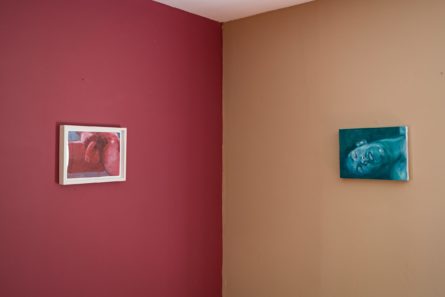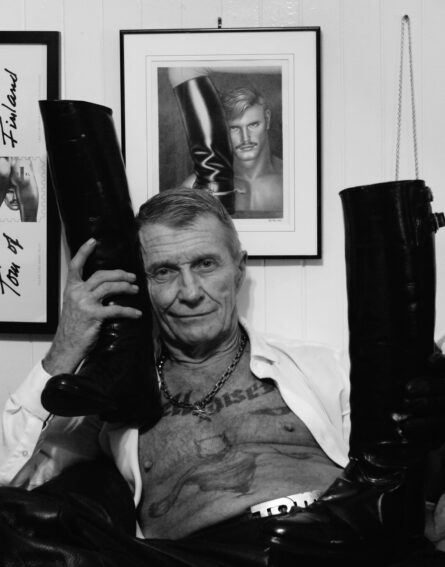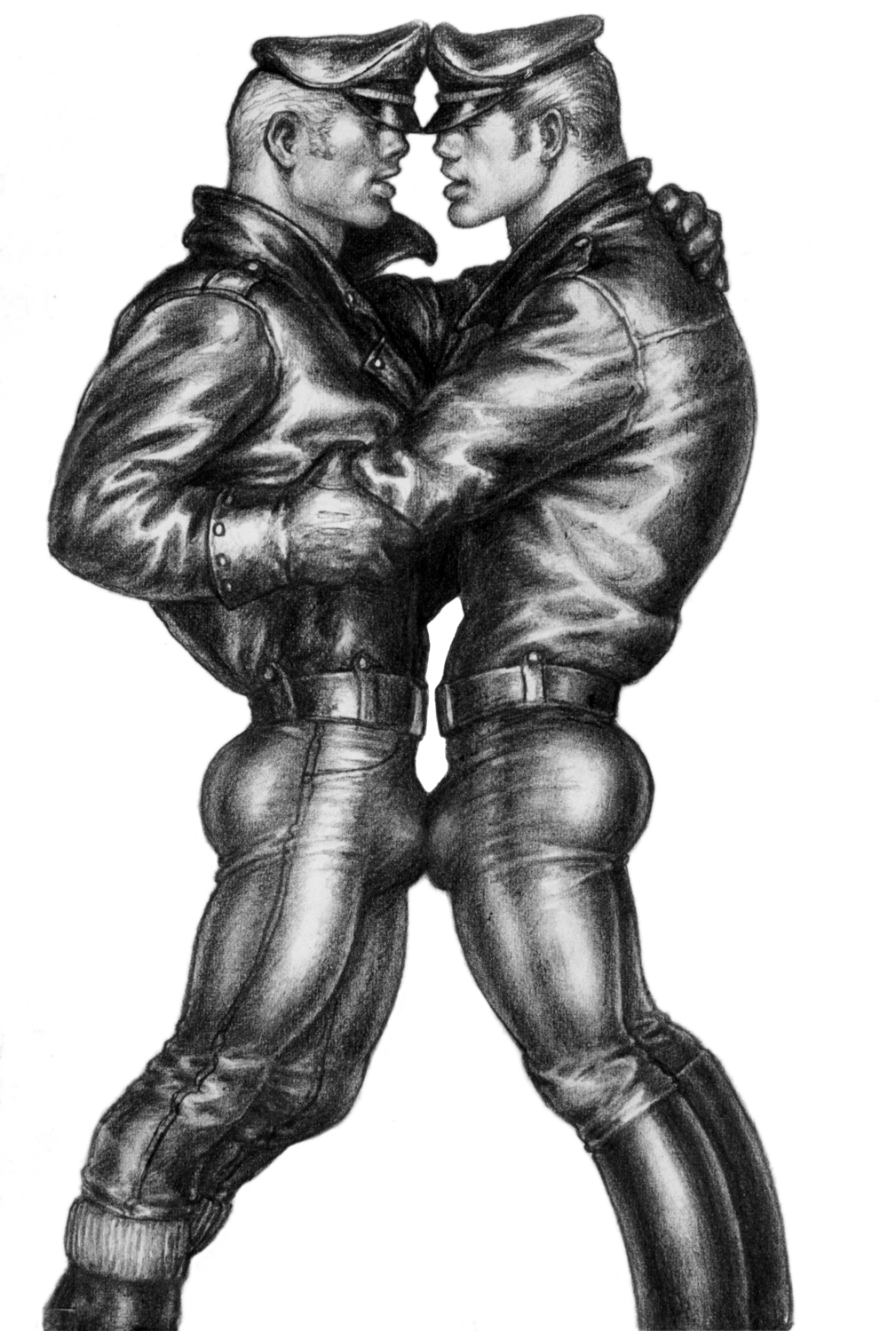Monday 10.26.20
AARON SKOLNICK
In conversation with Stuart Horodner, the Director of the University of Kentucky Art Museum, the painter discusses cruising in rural areas and his current exhibition, Between Two Suns, an installation organized by MARCH in an abandoned farmhouse in Kentucky.

Hi Aaron. How’s Hudson this morning? How long have you lived there now? It’s a nice cool morning with great light in the studio.
How important are the conditions in the studio for you? In what way?
The amount of space to work, the connection to a domestic setting. The spaces I think of you working in are all relatively intimate. It’s very important. I like a rather small studio as my work is not that big in scale. The studio being in my living space is important to me as of now as I like to be able to walk in whenever I want.
Seems like some of what you are making work about is people (men) in a state of naturalness, as if caught between the bedroom, bath, kitchen, etc. I have been focusing on cruising the past 6 months, men resting, waiting, watching action happen around them. The fact that they are set in a rural moment allows them to rest more in my eyes. There is a real art to being patient.
What was the impulse to take on “cruising?” And this brings up the fact that you’ve always worked on one specific series at a time. How are these new images coming about…through drawing, photos? Cruising came about when I was thinking about my faggot tattoo, and why I have it — being called faggot and being made fun of before I came out for being very “theatrical.” Hiding in plain sight led me to thinking about how we hide our desires, how we look without being caught and how we occupy space, how desires dictate that risk factor for occupying space and being forced to travel for those desires. …

Thursday 09.24.20
LOUIS FRATINO SCULPTURES

In the frosty chill of early 2020, we visited Louis Fratino at the Bushwick studio he shares with his partner, designer Thomas Barger. The open plan was split by the couple’s starkly different styles, the colorful romance of Fratino’s paintings both in conversation and at odds with the puffy and softly spiny architecture of Barger’s furniture. As their dog, Margaret, glowered sharply at us from her roost, the couple welcomed us graciously. With candor and charm, Fratino entertained my inquiry of his recent foray into sculpture and the current landscape of queer figurative painters. Our conversation often returned to the non-linearity of space and time — to the spurious notion of progress and the recognition that art history is not a monolith. After taking notes during our tête-à-tête, I sent him a series of questions.
How does the act of drawing compare to painting or sculpting? Drawing is subconscious and capricious. If art making is about revealing an interior self, then it is drawing that brings me there. Painting or sculpting becomes heavy because it asks to live in our world, which is burdened by rules of perception. Drawing can be anything from a written letter to a hair — it is more free to wander.
When you draw, do you make work from your own perspective, or from a state of astral projection, floating outside of yourself? It depends on the source of the drawing, which ranges from total invention, appropriating other artworks, or photography. When I draw from invention or memory, I am often several feet behind myself — seeing myself and others. …

Wednesday 09.09.20
DANIEL MARCELLUS GIVENS

There is an accessibility to the work of Daniel Marcellus Givens that is rarely matched. His marker drawings of bodies radiating auras, colliding and fusing together, kissing, wrestling, dancing, or flying through the air, in their abstraction, are at once both mysterious and instantly identifiable. They are unpretentious in their simplicity, being as much about the unfussy materiality of marker on paper as the metaphysics of meditation and love — difficult to describe, but easy to know once experienced.
Growing up as an ‘80s child in Chicago, Givens was raised by MTV. He digested music videos as multidimensional art, exhilarated by their combination of catchy melodies, poetic lyrics, and hypnotic visuals that satisfy the senses and saturate mass culture. He often sat in the DJ booth as his brother spun tracks for parties, and later with a drum machine and keyboard sampler, he became a DJ too and also made his own music. “As a little kid, one of my best friends and I were really into Prince,” he remembers. “We watched Purple Rain every day for a whole summer. We were way too young, but I had a friend who could get us into the movie theater.” Later Givens and that friend decided to start a band. “We didn’t have any instruments, so we decided to make them with some markers and construction paper. We copied the [artist formerly known as Prince] symbol-shaped guitar, using rulers as the guitar necks. We’d hang out in the backyard lip-syncing to Prince songs. …

Wednesday 09.02.20
Daniel Rampulla: Wild Place
A photographer exposes his desires and his pains of coming out.
Thursday 08.27.20
Forrest Bess

Before ‘gay visibility’ if a person discovered same-sex attraction within their heart but was not wealthy and privileged enough to construct underground networks to live comfortably in an alternate lifestyle, for some, the only answer was to seek meaning in life through esoteric study. In global cultures, comparative anthropology, non-western religions, and erotic mysticisms, one could inhabit an identity nobler than ‘local cocksucker.’ Who wouldn’t rather be a Uranian, a sexual invert, or follower of Ganymede than a mere homosexual stuck in a hetero-normative culture?
Forrest Bess lived in a shack on the gulf of Mexico, not far from Houston, Texas. He woke before dawn each morning to sell bait to local fishermen. He led an isolated life, painting his ‘visions’ in oil on small canvases and maintaining a distant but steady correspondence with sympathetic fellow travelers in New York and elsewhere. In time, Bess would meet prominent gallerist Betty Parsons, gain popularity as a pure abstract painter, and become an art world legend, his paintings revered as objects of desire.
Texas is quite unlike the rest of the United States. Physically bigger than most countries in Europe, many residents understand their state to be another country. Texas’ libertarian ideology allows for a greater personal eccentricity to be socially and institutionally supported in ways that are rare in the highly controlled worlds of Boston, Washington DC, and New York. Houston only became a major city after 1900, when a hurricane wiped out the bigger city of Galveston. The city then grew quickly after the lucrative commodity of oil and natural gas were found in abundance. …

Friday 07.03.20
Eric Lotzer
The artist creates a fantasy world where creatures of all kinds are free to explore their most primal instincts.
Thursday 05.21.20
The Lesbian, Gay, Bisexual, & Transgender Center in New York is hosting a Queer Art Benefit, May 21 – June 1, 2020.
Donate!
Friday 05.08.20
Durk Dehner

Some spaces are full of magic. TOM House is undeniably one of them. Nestled in the hills of LA’s Echo Park neighborhood, the residence houses the Tom of Finland Foundation along with a vibrant community of gay crusaders, not to mention one of the largest collections of homoerotic art in the world.
In the summer of 2016, I was fortunate enough to be inducted into TOM House as its artist-in-residence, where I could work on a (forthcoming) collection of erotic nonfiction stories inspired by the space. In the beginning, I couldn’t comprehend how living there would completely transform me. Beyond my exposure to the archives housed onsite, I was embraced by a gay family, one that supported and encouraged me to develop into a more realized version of myself. TOM House, I learned, is home to a collective vision: to celebrate our nature as sexual beings.
As I write this, the whole place is bustling. The foundation is creating artwork for three European exhibitions shipping out this week. This kind of rumpus is common, but beneath the wild operation and the frequent events and artist collaborations, we are a loving ménage. In a rare quiet moment, I was able to snatch away the current head of the foundation and the house, Durk Dehner, who is, among other things, the former lover of Touko Laaksonen, the late artist originally behind the Tom of Finland moniker.
Durk is the head of our tribe. He’s the one who brought the magic and, ultimately, Tom of Finland to this very house. …









